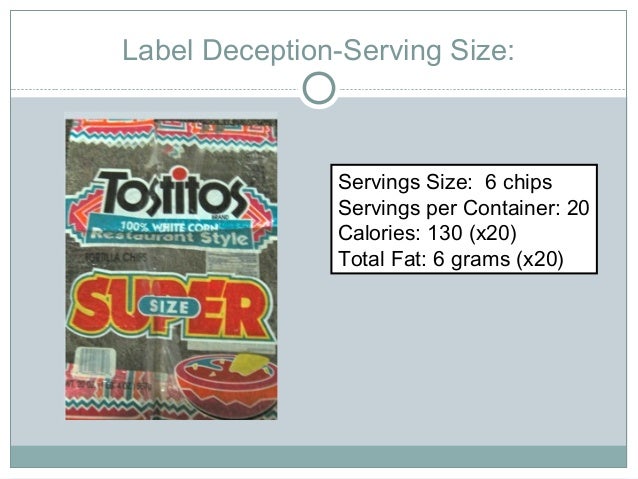41 reading labels on food products
Food labels - NHS Colour-coded nutritional information tells you at a glance if the food has high, medium or low amounts of fat, saturated fat, sugars and salt: red means high amber means medium green means low In short, the more green on the label, the healthier the choice. Food Labels | Nutrition.gov The U.S. Food and Drug Administration (FDA) has updated the Nutrition Facts label on packaged foods and beverages with a fresh design that will make it easier for you to make informed food choices that contribute to lifelong healthy eating habits. What's in a Name? What Every Consumer Should Know About Foods and Flavors
How to Read Food Labels Without Being Tricked - Healthline Nutrition labels state how many calories and nutrients are in a standard amount of the product — often a suggested single serving. However, these serving sizes are frequently much smaller than what...
Reading labels on food products
PDF Food Labeling Guide Food Labeling Guide Additionalcopies are available from: Office of Nutrition, Labeling, and Dietary Supplements HFS-800 Center for Food Safety and Applied Nutrition Food and Drug Administration... How to Understand and Use the Nutrition Facts Label | FDA For certain products that are larger than a single serving but that could be consumed in one sitting or multiple sittings, manufacturers will have to provide "dual column" labels to indicate the... Reading food labels - Food Allergy Education The Food Standards Code requires the following common food allergens (as well as sulphites and gluten) to be declared on packaged food labels by 25 February 2026: The Food Standards Code also requires that added sulphites in concentrations of 10mg/kg or more must also be declared on food labels of packaged foods. An ingredient.
Reading labels on food products. Consumer Research on Labeling, Nutrition, Diet, and Health According to the OLR results, reading the food label often was significantly associated with less reported difficulty following a GFD, whereas consuming packaged processed foods and looking for GF... Food Labeling & Nutrition | FDA Food labeling is required for most prepared foods, such as breads, cereals, canned and frozen foods, snacks, desserts, drinks, etc. Nutrition labeling for raw produce (fruits and vegetables) and... Reading food labels: Tips if you have diabetes - Mayo Clinic Reading food labels can help you make the best choices. Start with the list of ingredients When you're looking at food labels, start with the list of ingredients. Keep an eye out for heart-healthy ingredients, especially those that are less processed, such as whole-wheat flour, soy and oats. Reading Labels For Clean Eating | The Gracious Pantry Almonds. Walnuts. These are all examples of what clean foods are. Think of it this way. You want to purchase INGREDIENTS. Not prepared foods. Yes, this takes a bit of forethought and planning. Clean eaters do cook a lot, and most of them love it. Just know that over time, the cooking and prep work do become routine.
Understanding Food Nutrition Labels | American Heart Association Learn what to look for on the label. 1 - Start with the serving information at the top. This will tell you the size of a single serving and the total number of servings per container (package). 2 - Next, check total calories per serving and container. How To Read Food Labels - 10 Tips | Pritikin Program For Eating Right Here are the basics for how to read food labels, consolidated into 10 quick-reference tips, compliments of Kimberly Gomer, Director of Nutrition at the Pritikin Longevity Center in Miami, Florida. ... If a product has 2 grams of fat or less per 100 calories, its fat content is within Pritikin guidelines for processed foods: the fat, per serving ... How to Read a Food Label - FoodAllergy.org Starting Jan. 1, 2023, allergen labeling of sesame will be required under the Food Allergy Safety, Treatment, Education and Research (FASTER) Act of 2021. Ingredients and manufacturing processes can change without warning. Make a habit of carefully reading labels to ensure you avoid any potential allergens. "May Contain" Statements How To Read Food labels for Sugar | My Sugar Free Kitchen 1 teaspoon of sugar is approximately 4 grams The World Health Organisation recommends no more than 10% of your daily food intake (ie: calories) should be made up of added sugars. What does this look like in real terms? For a 2,000-calorie diet, 10% would be 50 grams, or 12.5 teaspoons of added sugar per day. How to calculate 10% of Daily Calories
Food Label Reading - What You Need to Know - Drugs.com Shoppers can tell which foods are higher or lower in vitamins and minerals. Eat a wide variety of foods so that these % numbers from all of your food add up to 100% each day. Following are the recommended daily amount of some vitamins and minerals. Vitamin A % - 5000 units per day. Vitamin C % - 60mg per day. Read the Label Youth Outreach Materials | FDA Read the Label Youth Outreach materials challenge kids (ages 9 to 13) to look for and use the Nutrition Facts label on food and beverage packages. The materials include fun, easy tips and targeted ... PDF Lesson 10 Decoding Food Labels - Johns Hopkins University Decoding Food Labels [Lesson Duration: 50 minutes] Lesson Overview Explore the common types of food labels and how to interpret them. Identify who regulates and verifies the accuracy of food labels. Food products are labeled with words like "natural" and "humane," and some are certified as USDA Organic or gluten free. Stages of reading the food label - Sanitarian.net Here are the steps to read labels 1- CALCULATE THE PORTION AMOUNT Phrases such as "100 grams…", "1 serving (Ex: 40 g)", "1 package contains approximately 2 servings" written on food labels are very important.
How To Read Food and Beverage Labels | National Institute on Aging "Use by" tells how long items will be at peak quality. If you buy or use the product after that date, some might be stale or less tasty. "Best if used by" (or "best if used before") tells how long the item will have the best flavor or quality. None of these dates tell you when an item is no longer safe to eat or drink.
The Importance of Reading the Food Label and Nutritional Facts The Importance of Reading Food Labels This information does two things: The Basics of Reading a Nutrition Label 1. Serving Size 2. Calories per Serving 3. Percent Daily Values 4. Nutrient Contents 5. Vitamins & Minerals 6. Ingredient List Putting it All Together Reading food labels makes a big difference when it comes to your family's health.
5 tips for decoding food labels - Harvard Health Here are 5 ways to make food labels work for you: Size matters. Serving size is always the first item on the label. All other information is based on that serving size. The servings per container tell you know how many portions are in the whole box, package, or can. Beware: many packages contain more than one serving.
Why Is Reading Food Labels Important? | livestrong Provides Key Information The nutrition label provides key information such as serving size, calories, total fat, saturated fat, cholesterol, protein, carbohydrate and vitamin content. The label also contains a list of the ingredients. This information helps you stay on track with your daily targets.
Food Label - Importance of Reading Food Labels - Value of Reading Food Labels To Find Healthier ...
Food Labels | CDC All the numbers on this label are for a 2/3-cup serving. This package has 8 servings. If you eat the whole thing, you are eating 8 times the amount of calories, carbs, fat, etc., shown on the label. Total Carbohydrate shows you types of carbs in the food, including sugar and fiber. Choose foods with more fiber, vitamins, and minerals.
13 Misleading Food Label Claims and How Not to Be Tricked Products labeled sugar-free may also have higher levels of fat in order to make up for the taste and texture that is lost when sugar is removed. 2. Label Says "Fruit-Flavored" Reading on a label that a product is fruit-flavored suggests that the product is flavored with real fruit. This, however, is not necessarily the case.
Learning To Read Labels :: Diabetes Education Online Let's practice with this example label. The serving size listed is 3 pieces (or 90 grams if you are weighing the product). The grams of total carbohydrate per serving is 30 grams. If you eat 6 pieces, that is two servings. You would be getting 60 grams of total carbohydrate (1 serving = 30 grams of total carbohydrate, 2 servings = 60 grams of ...
Food Allergy & Anaphylaxis | Food Labeling | Food Labels Read labels each and every time before eating any food product. Ingredients can change over time, or may vary depending upon the size of the product (e.g. jumbo vs snack size). Statements advising that products may/might contain or are made in shared facilities with a food allergen are purely voluntary.
Young Adults Don't Read Food Labels - Forbes These labels may not be truthful or understandable. The report looked at comparison of five food labels (based on criteria of who is involved, actions, and market outcomes): Nutrition labeling,...
How to read food labels | Food safety at home | NZ Government Reading food labels helps you know which food and drink is right for you. Here's what each part of the label means and what to do if you find a problem with a food label. 'Use by' or 'best before' dates (date marks) Date marks indicate how long food can be kept before it starts to deteriorate or becomes unsafe to eat.
Reading food labels - Food Allergy Education The Food Standards Code requires the following common food allergens (as well as sulphites and gluten) to be declared on packaged food labels by 25 February 2026: The Food Standards Code also requires that added sulphites in concentrations of 10mg/kg or more must also be declared on food labels of packaged foods. An ingredient.
How to Understand and Use the Nutrition Facts Label | FDA For certain products that are larger than a single serving but that could be consumed in one sitting or multiple sittings, manufacturers will have to provide "dual column" labels to indicate the...
PDF Food Labeling Guide Food Labeling Guide Additionalcopies are available from: Office of Nutrition, Labeling, and Dietary Supplements HFS-800 Center for Food Safety and Applied Nutrition Food and Drug Administration...













Post a Comment for "41 reading labels on food products"